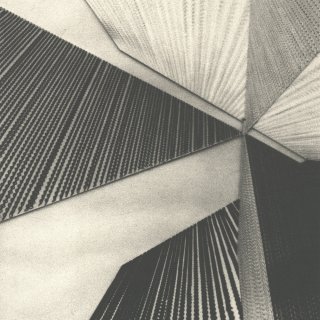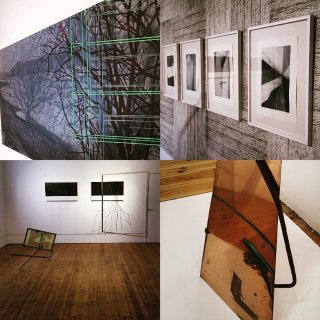Yasmin Ali
Urbanism // Design
Abstraction from Architecture
October 31st, 2015Abstraction from Architecture was an exhibition recently held at Edinburgh Printmakers. It was curated by the artist Bronwen Sleigh, known for the influence of architectural features within her work which was also featured within this exhibition. It also features the work of George Charman, Carla Scott Fullerton, and Andrew MacKenzie, all artists chosen by Sleigh for their focus on architecture.
Bronwen Sleigh's work features manmade places and forms, including architecture and a careful documentation process to translate the shapes to 2d prints and 3d drawings and sculptures. Her eye for architecture brought together these artworks and artists through careful curation.
MacKenzie's work features abstracted line drawings in bright pastelwork overlaid on traditional landscapes. Two paintings, one from Edinburgh University's collection and one from London, plus four pastel and gouache on paper drawings made bespoke for this exhibition including 2 lithographs made with EP assistant director Alastair Clark.
Sculptor Fullerton worked with Glasgow Print Studio to produce sculptures which playfully incorporated screens for screenprinting within the work, as well as moulded copper sculptures from etching and litho plates
Charman's work combines surface quality and the use of printmaker to abstract a surface, as well as understanding the role of the viewer's response to the environment. A featured piece includes a rubbing from a building from his neighbourhood estate, combined with a screenprint dusted with cement to produce a mesmerising pattern. A series of work in frames (pictured) explore the nature of interior space through collaged printed imagery of a striking installation featuring chains.
12 September - 24 October 2015
edinburghprintmakers.co.uk/exhibitions/Abstraction-from-Architecture
Abstraction from Architecture
Artists: George Charman, Carla Scott Fullerton, Andrew McKenzie and Bronwen Sleigh
Entries in: Springburn Winter Gardens Competition
September 21st, 2014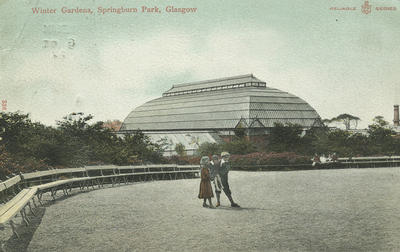
Restore Springburn Winter Gardens is a passionate and informed community-led project by Springburn Winter Gardens Trust to restore Scotland's largest glasshouse, the 'A-listed' Springburn Park Winter Gardens, for future generations of Glaswegians. It has been backed by an architectural competition for a pavilion to be constructed in the interim phases of the project during restoration.
The competition, run by GIA Glasgow Institute of Architects in association with NG Homes and MAKLAB, has attracted a range of competition entries, whose 3D printed models and images are currently on show. To coincide with Doors Open Days, the top 25 are facing a design competition public vote is on at Mosesfield House today from 11am till 5pm.
Event Review: Beyond Borders Festival 2014, 23rd/24th August 2014
August 27th, 2014

This year I attended Beyond Borders International Festival of Literature and Thought, which has been running since 2010, previously known as Borders, Books and Bikes. The programme was packed with cycle tours, guided walks, author’s talks and political debates and discussions. A central theme has always been Peace and Conflict, and contested territories were discussed in several forums. The event is held in the grounds and within Traquair House, Scotland’s oldest continually inhabited house, a picturesque stately home near Peebles.
I was lucky to sit in on a dialogue with war photographer Paul Conroy’s lunchtime talk subtitled ‘Seeking Sanctuary’ about his British Red Cross exhibition of the same name. Here Paul described his photographic portraiture project documenting Syrian refugees seeking asylum in Scotland. Conroy told of the challenges of depicting people without showing their faces, in rooms with no real distinctive features, and the daunting task of portraying character in such surroundings. In Conroy’s words, he described it as more challenging than his war photography overseas. The photographs were also on display in the Exhibition tent and are on tour throughout the UK this year.
The following day, for the first talk we sought sanctuary in the chapel at Traquair House for a discussion with Feeding Frenzy author Paul McMahon, about the politics of food in the 21st century. McMahon was joined by Delfina Foundation director and Director of Visual Arts of Beyond Borders Scotland, Aaron Cezar, who presented slides of recent artwork on food politics from the Delfina Foundation for hungry eyes. Lawyer, author and academic Oscar Guardiola-Rivera led the discussion; and also chaired The Rule of Law discussion, which is an event common to many previous Beyond Borders’ Festivals. Sir Jeffrey Jowell QC of the Bingham Centre for the Rule of Law, the UN’s Andrew Gilmour, and David Marshall were on the panel to discuss what the rule of law means for today’s international policymakers, and how to sensitively – and modestly – intervene in international relations.
I found most provocative the discussion ‘Lifting the veil’, in particular, details of journalist and Iranian correspondent Ramita Navai’s book Tehran: City of Lies, which exposes details of contemporary urban life in Iran, including double-standards and deceptive appearances within society. Navai was able to infiltrate areas of Tehran invisible to many of its citizens and tell surprising stories which have been woven into narrative fiction. Also present was author and columnist Yasmin Alibhai-Brown positing the counter question regards the danger of Muslim women in the West reassuming the veil. The discussion was chaired and led by author Bonnie Greer OBE.
Beyond Borders events continue with its film festival in Edinburgh this week, and more events planned for 2015. For details of future events go to the website here.
// With Thanks to the Beyond Borders Team based in Edinburgh
Goodbye Glasgow Games
August 4th, 2014

Forget Usain Bolt's runaway remark, Glasgow's Games were really positive, and not just for the sporting heroes and fans - here's a snapshot of the key cultural happenings to supplement the sporting events:
1. We Are Panel
Too many arts activities to do mention, but one standout strand was the souvenir project and programme run by Panel Glasgow, based in the foyer of South Block Studios. Every purchase received a special edition medal set of Tunnock's Teacakes.
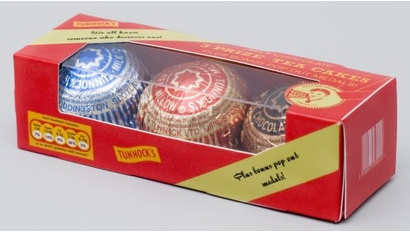
Special Edition Teacakes by Tunnock's
2. The Empire Cafeì
Across the way over at The Briggait, The Empire Cafeì held a series of discursive and reflective events exploring Scotland's connection with the Slave Trade, reminding us of the historic disparity in fortunes within the Commonwealth. Its beautiful, minimalist branding by Graphical House has had the design circles talking.
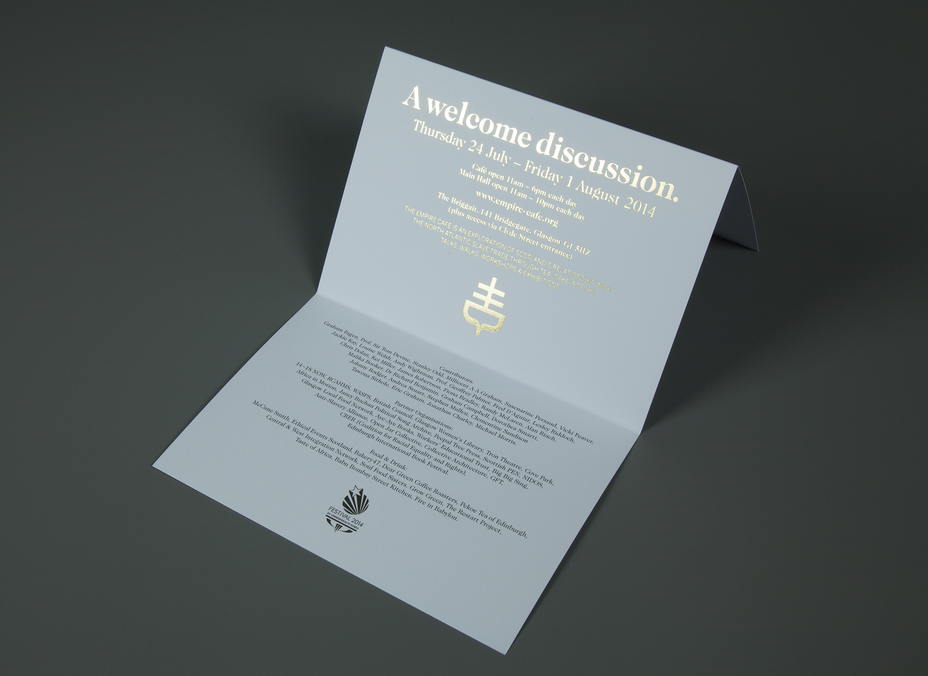
The Empire Cafeì Branding by Graphical House
3. Glasgow Mix Tape
On the rainy penultimate day of the Games, East End Social hosts a gig on The Green with a bill glittering with Glaswegian stars to be proud of - all for free.
4. Pop-up events and premises
There were lots of interesting pop-up stalls as part of Shedzone within the Green, and also along High Street. The Pop-up Fish Plaice Kitchen & Bar has been particularly successful and had its run extended until the 14th.
5. Last but not least...Legacy
It's not just about those 11 days - there is a programme in place to extend the regeneration initiatives catalysed by The Games, as well as the conversion of The Athlete's Village.
// Read more about it at www.legacy2014.co.uk

Book Review: Derelict Glasgow
March 7th, 2014
Derelict Glasgow is a book, website, exhibition and symposium curated by architectural photographer and designer Joe Shaldon, with support from A+DS. The book is the culmination of a personal project, which has gained acclaim from professional circles and the public alike, with a limited sold-out print run and pre-orders for another in the pipeline. The Derelict Glasgow website is popular, with over 15,000 visitors per month and no advertising other than social media and word-of-mouth. The exhibition runs for six weeks from 24th January 2014 onwards at the Lighthouse, following the sold-out symposium.
With related topics in vogue such as urbexing (urban exploring) and the new photo-documentary genre dubbed ‘ruin porn’, the book is on the money in terms of current trends, but also hits a note with more longevity. Glasgow is a city with a long history of contested demolitions, including works of Alexander Greek Thomson in the sixties, as well as more recent high-rises like Red Road and Sighthill, threatened by waves of gentrification via initiatives like the Commonwealth Games regeneration programmes.
The limited edition book, subtitled volume 1, is a neat archival collection of photographs of mainly vacant and disused buildings around Glasgow, alongside a concise short history and description for each. The photos alone form a powerful photo-essay of Glasgow’s urban decay and a harsh reminder of the cracks that can emerge in the urban fabric of shrinking cities. Despite their dereliction, these buildings are often looked upon with a sense of affection attached to nostalgia, which in part, explains the popularity of the subject matter, especially with the local community. The rest is explained by seeing this impressive body of work.
// Catch the exhibition at The Lighthouse, Glasgow until 4th March, Free.


